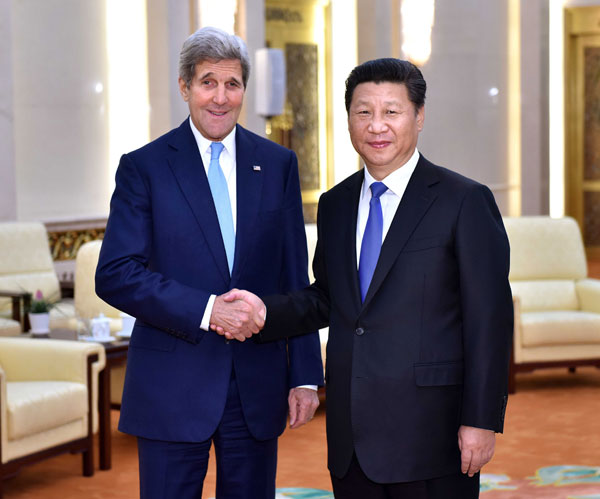Xi Jinping's US visit will highlight China-US economic ties
- By John Ross
 0 Comment(s)
0 Comment(s) Print
Print E-mail China.org.cn, September 18, 2015
E-mail China.org.cn, September 18, 2015
|
Chinese President Xi Jinping (R) meets with US Secretary of State John Kerry at the Great Hall of the People in Beijng, capital of China, May 17, 2015. [Photo/Xinhua] |
Chinese President Xi Jinping's forthcoming state visit to the U.S. offers an opportunity to understand the great potential for mutually beneficial economic relations between the two countries. This goes well beyond them being the world's two largest economies to revealing their fundamentally complementary economic character.
Analysing their most fundamental economic features demonstrates this clearly, and helps explain why China-U.S. economic relations can be stable and mutually beneficial for decades to come. It also shows why the anti-China attitude of American neo-conservatives damages not only China, but also the U.S.
In 2014, China-U.S.trade, standing at US$650 billion, was the largest between any two countries in the world outside the North American Free Trade Area (Canada, Mexico and the U.S.). For the U.S. it was second only to trade with Canada – the latter now being almost a domestic base for U.S. production.
In the period 2007-14, namely, since the beginning of the global financial crisis, U.S. trade with Canada increased by US$121 billion, but that with China increased by US$237 billion.
The driving force of such rapid trade expansion goes beyond them being the world's two largest economies to the fact that China is by far the largest developing economy, while the U.S. is the world's most advanced economy. They complement each other rather than directly compete.
Measured at current exchange rates, preferred by China, it is the world's second largest economy. Measured in terms of Purchasing Powers Parity (PPPs), as many Western economists prefer, China is the world's largest economy. Whichever you use, the productivity gap between China and the U.S. remains huge.
At current exchange rates, China's per capita GDP is 14 percent of the U.S., while in terms of PPP, it is 24 percent. The fact they are at very different productivity and wage levels, means China provides a gigantic market for U.S. high value added products, while China can supply medium technology products at prices the U.S. cannot match due to its far higher labor costs.
If the latest year's growth rate of per capita GDP for the two countries were maintained, 6.8 percent for China and 1.6 percent for the U.S., China would not be able to reach U.S. per capita GDP until 2043.
The reason this gap cannot be closed rapidly is also clear. Contrary to neo-liberal myths, the U.S. economy is essentially powered by capital investment. Analysed in fundamental terms, an economy's sources of output and growth can be divided into capital investment, labor input and Total Factor Productivity (TFP) – the latter measuring the effects of economic policy, improvements in technology etc.






